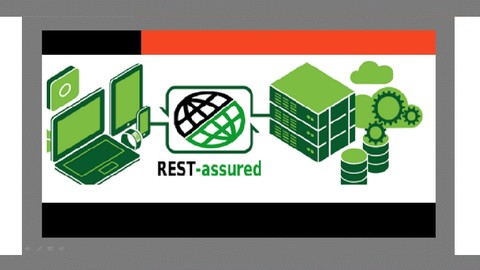
Step by Step API Automation using RESTASSURED & JAVA
Step by Step API Automation using RESTASSURED & JAVA, available at $49.99, has an average rating of 4, with 130 lectures, based on 207 reviews, and has 936 subscribers.
You will learn about End to End REST API automation using REST ASSURED and JAVA Programming Design REST API Testing automation framework from scratch Practical knowledge of basic to advance level of Java Programming Detailed understanding of Java Concepts, Programming and its implementation in RestAssured Able to crack REST ASSURED interviews with Java Programming skills This course is ideal for individuals who are Software Testers/ QA looking to test/automate REST API testing or Manual Testers looking to switch in to Automation / REST API Automation or Freshers looking opportunity in Software Testing It is particularly useful for Software Testers/ QA looking to test/automate REST API testing or Manual Testers looking to switch in to Automation / REST API Automation or Freshers looking opportunity in Software Testing.
Enroll now: Step by Step API Automation using RESTASSURED & JAVA
Summary
Title: Step by Step API Automation using RESTASSURED & JAVA
Price: $49.99
Average Rating: 4
Number of Lectures: 130
Number of Published Lectures: 110
Number of Curriculum Items: 130
Number of Published Curriculum Objects: 110
Original Price: $69.99
Quality Status: approved
Status: Live
What You Will Learn
- End to End REST API automation using REST ASSURED and JAVA Programming
- Design REST API Testing automation framework from scratch
- Practical knowledge of basic to advance level of Java Programming
- Detailed understanding of Java Concepts, Programming and its implementation in RestAssured
- Able to crack REST ASSURED interviews with Java Programming skills
Who Should Attend
- Software Testers/ QA looking to test/automate REST API testing
- Manual Testers looking to switch in to Automation / REST API Automation
- Freshers looking opportunity in Software Testing
Target Audiences
- Software Testers/ QA looking to test/automate REST API testing
- Manual Testers looking to switch in to Automation / REST API Automation
- Freshers looking opportunity in Software Testing
REST Assured API is one of the most popular library when it comes to automating the REST APIs. Most of the today’s web applications are backed by the Micro services architecture and the REST APIs.
REST stands for REpresentational State Transfer. REST is web standards based architecture and uses HTTP Protocol for data communication.
In REST architecture, a REST Server simply provides access to resources and REST client accesses and presents the resources.
What topics are covered in this course?
-
API Basics
-
JSON & JSON Path
-
End to End Setup
-
Java Programming Basics
-
Rest Assured – Setup, Write Test Case
-
Rest Assured – Test Case in TestNG format
-
Rest Assured – Assertion (On header, body and status code)
-
Serialization & De-serialization: POJOs
-
HashMap to JSON object
-
ArrayList to JSON array
-
Complex POJO Example
-
Full JSON body matching
-
Parameterization using TestNG Data provider
-
Rest Assured – Request Specification
-
Rest Assured – Response Specification
-
Rest Assured – Automate Post, Put, Del
-
Rest Assured – Multiple ways to send request payload
-
Rest Assured – Complex JSON in request body
-
Rest Assured – Request Parameters
-
Rest Assured – JSON Schema Validation
-
Rest Assured – Logging Filters
-
Rest Assured – Configs
-
Framework Design
-
Code Management
-
Jenkins Integration
-
Java Coverage
-
OOPS Concepts
-
Excel Handling
-
Database Handling
-
TestNG Basic to Expert
-
Collections
-
Serialization & De-serialization: POJOs
-
HashMap to JSON object
-
ArrayList to JSON array
-
Complex POJO Example
-
Full JSON body matching
Framework Development->
-
BDD Framework with Features
-
Scalable Framework Structure
-
Configurations
-
Reporting
-
Automate positive and negative scenarios
-
Data driven using TestNG Data Provider
-
Cucumber Implementation
-
Best Practices
-
Property and Configuration
-
Integration with Git
-
Integration with Jenkins
Tool, Library & Technology
-
Eclipse
-
Rest Assured
-
TestNG
-
Cucumber
-
Reporting
-
Java
-
Allure Reports
Outcome of this course
1. Expertise in Java Programming
2. Expertise in API Concepts
3. Able to design End to End API Automation Framework
4. Ready to face Automation interviews
Course Curriculum
Chapter 1: Course Introduction
Lecture 1: Agenda of this Course
Chapter 2: ***** STEP 1 ***** WebService/API Basics | Advantage
Lecture 1: What is WebService
Lecture 2: WebService Example
Lecture 3: Advantage of WebService over WebBased Application
Lecture 4: Difference between API and WebService
Lecture 5: Different type of Services : Soap and Rest
Lecture 6: Micro Service Introduction
Lecture 7: Understand UDDI
Chapter 3: ****STEP 2 ****Java Environment Setup {Skip this Section if comfortable in Java}
Lecture 1: Java(JDK) Installation on Windows Machine
Lecture 2: Eclipse Installation : Setup environment for Code Writing
Lecture 3: Environment Setup- Rest Assured
Lecture 4: Setup Sample Applications for Practice
Chapter 4: Eclipse & Java Introduction | Lets Start basic programming
Lecture 1: Introduction to Eclipse | Walkthrough to Eclipse Environment
Lecture 2: Start Java programming – Project & Package
Lecture 3: How to Define Variables & Constants in Java
Lecture 4: What is Class ? & How to access class members by using Object
Lecture 5: Methods(Functions) in Detail : Different types of Methods
Lecture 6: Constructor | What is Constructor and How to Write Constructor
Lecture 7: Where to use Constructors (Practical Usecase)
Lecture 8: Read data from user at runtime : Take User Input
Chapter 5: Step by Step Condition Handling | How and Where to use Condition Handling
Lecture 1: Simple Condition Handling – IF – Else (Handle 2 conditions)
Lecture 2: Multiple Condition Handling (If – Else if – else) with practice exercise
Lecture 3: Condition handling with Logical OR / AND
Lecture 4: Nested Condition Handling (Condition inside Condition)
Chapter 6: Step by Step Looping | For – While – Do While – For Each
Lecture 1: For Loop : Run Loop with increment and Decrement Order
Lecture 2: While Loop
Lecture 3: Do While Loop
Lecture 4: For Each loop : Advance For Loop for Group of Data
Lecture 5: Nested Loop : Loop inside Loop
Chapter 7: String Handling : What is String, Use different functions available in String
Lecture 1: String Handling – Part1 : What is String -String Functions(Length, Upper, Lower)
Lecture 2: String Handling – Part2 : String Functions- Replace, SubString, Split, Concat
Lecture 3: String Handling – Part3 : String Comparison
Lecture 4: Array In Java
Lecture 5: Multi dimension Array
Chapter 8: File Handling : Read and Write File Data
Lecture 1: File Reader – File Reader (Read data character by character)
Lecture 2: File Read – Buffered Reader (Read data line by line)
Lecture 3: File Write – File Writer : Write data character by character
Lecture 4: File Write – BufferedWriter : Write data line by line
Chapter 9: OOPS in Detail (Object Oriented Programming)
Lecture 1: Encapsulation : Wrapping up data & functions in single unit
Lecture 2: Inheritance : Transfer Property of a class to another class
Lecture 3: Types of Inheritance – Single Inheritance
Lecture 4: Types of Inheritance – Multilevel Inheritance
Lecture 5: Types of Inheritance – Hierarchical Inheritance
Lecture 6: Polymorphism : Data Overriding (Override Parent Class Methods)
Lecture 7: Overloading (Compile Time Polymorphism)
Lecture 8: Overriding (Runtime Polymorphism)
Lecture 9: Abstraction with Interview Questions
Lecture 10: Interface : To Achieve 100% abstraction
Lecture 11: Multiple Inheritance using Interface
Lecture 12: Hybrid Inheritance using Interface
Chapter 10: Access Modifiers : Access Class members at different places
Lecture 1: public modifier : Access members throughout package
Lecture 2: private modifier : Access members within class
Lecture 3: default modifier : Access members within package
Lecture 4: protected modifier : Access members within package and child class
Lecture 5: Access Modifiers on class level
Chapter 11: Type Casting
Lecture 1: Implicit & Explicit Type Casting
Lecture 2: Explicit Type Casting – By Classes
Chapter 12: Exception Handling in Java
Lecture 1: What is Exception & Exception Handling
Lecture 2: Throws keyword in exception handing
Lecture 3: Exception Handling using Try-Catch
Lecture 4: Exception Handling: Multi Catch block
Lecture 5: Finally keyword
Lecture 6: Throw keyword
Chapter 13: Important Keywords in Java{You Can Skip this Section if comfortable in Java}
Lecture 1: This Keyword
Lecture 2: Final Keyword
Lecture 3: Super Keyword
Lecture 4: Static Keyword
Chapter 14: Debugging
Lecture 1: What is Debugging
Lecture 2: Difference between Step Into | Step Over | Step Return
Lecture 3: Exception Breakpoint
Chapter 15: Learn Basics of MAVEN
Lecture 1: What is Maven | Why as Tester we use MAVEN
Lecture 2: How to setup maven project
Lecture 3: Understand POM.xml | Add Project Dependencies |Check Maven Repository Workflow
Chapter 16: Working with Excel (Apache POI )
Lecture 1: Setup Apache POI
Lecture 2: Read Data from Excel file
Lecture 3: Find number of rows and columns
Lecture 4: Read complete data from excel sheet
Lecture 5: Read Different formatted data
Lecture 6: Write data to File
Chapter 17: Property File
Lecture 1: Read content from Property file
Chapter 18: TestNG Concepts Basic-Advance
Lecture 1: TestNG Introduction and Setup on Eclipse
Lecture 2: Write First Test Case using TestNG with Basic Annotations
Instructors
-
Testing World
Director of Testing World -
Testing World Infotech
Working Professional, Having 9 Yrs of Experience
Rating Distribution
- 1 stars: 8 votes
- 2 stars: 12 votes
- 3 stars: 29 votes
- 4 stars: 58 votes
- 5 stars: 101 votes
Frequently Asked Questions
How long do I have access to the course materials?
You can view and review the lecture materials indefinitely, like an on-demand channel.
Can I take my courses with me wherever I go?
Definitely! If you have an internet connection, courses on Udemy are available on any device at any time. If you don’t have an internet connection, some instructors also let their students download course lectures. That’s up to the instructor though, so make sure you get on their good side!
You may also like
- Best Video Editing Courses to Learn in February 2025
- Best Music Production Courses to Learn in February 2025
- Best Animation Courses to Learn in February 2025
- Best Digital Illustration Courses to Learn in February 2025
- Best Renewable Energy Courses to Learn in February 2025
- Best Sustainable Living Courses to Learn in February 2025
- Best Ethical AI Courses to Learn in February 2025
- Best Cybersecurity Fundamentals Courses to Learn in February 2025
- Best Smart Home Technology Courses to Learn in February 2025
- Best Holistic Health Courses to Learn in February 2025
- Best Nutrition And Diet Planning Courses to Learn in February 2025
- Best Yoga Instruction Courses to Learn in February 2025
- Best Stress Management Courses to Learn in February 2025
- Best Mindfulness Meditation Courses to Learn in February 2025
- Best Life Coaching Courses to Learn in February 2025
- Best Career Development Courses to Learn in February 2025
- Best Relationship Building Courses to Learn in February 2025
- Best Parenting Skills Courses to Learn in February 2025
- Best Home Improvement Courses to Learn in February 2025
- Best Gardening Courses to Learn in February 2025























